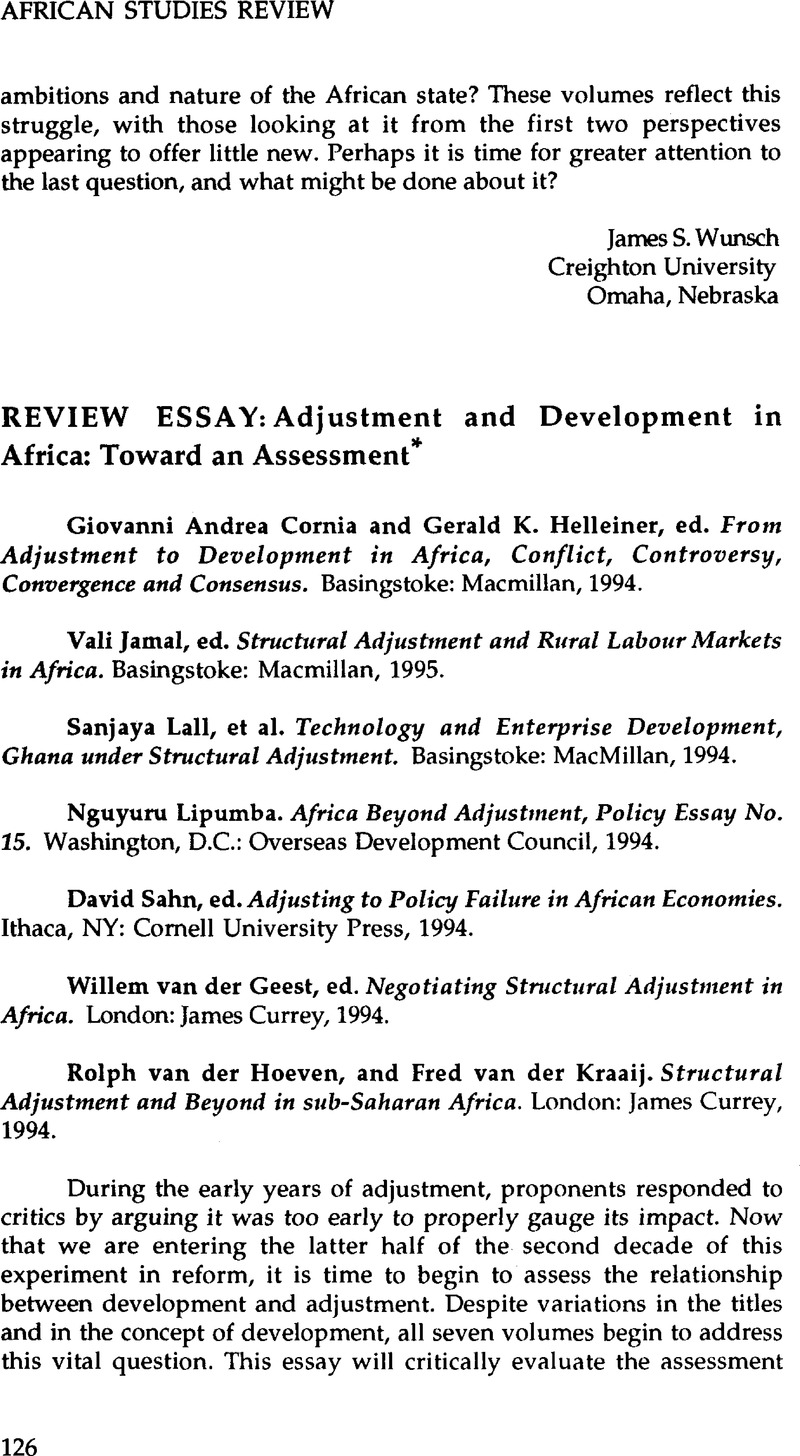Published online by Cambridge University Press: 23 May 2014

This paper was written as a Visiting Professor of the Institute of Economic Research, Hitotsubashi University, Tokyo, Japan.
1. See for example Mosley, Paul and Weeks, John, “Has Recovery Begun? Africa's Adjustment in the 1980s Revisited,” World Development, Vol. 21, No. 10, 1993 CrossRefGoogle Scholar.
2. See for example Stein, Howard, ed. Asian Industrialization and Africa: Studies in Policy Alternatives to Strudural Adjustment, (Basingstoke: Macmillan, 1995)CrossRefGoogle Scholar.
3. See World Bank, World Development Report, 1995, (Oxford: Oxford University Press, 1995) p. 162 Google ScholarPubMed.
4. While Lipumba considers the statistical testing in “Adjustment in Africa” to be a strong point of the study, other authors have been very critical of the method used. For a discussion of a number of weaknesses of the Bank study not incorporated in the Lipumba essay, see Mosley, Paul, Subasat, Turan and Weeks, John, “Assessing Adjustment in Africa,” World Development, Volume 23, No. 9, 1995 CrossRefGoogle Scholar.
5. See for example Lall, Sanjaya, Building Industrial Competitiveness in Developing Countries, (Paris: OECD, 1990)Google Scholar.
6. Much of this is clearly illustrated by the Bank's data in their World Development Report, 1995. See for example Tables 1, 8, 20, 25, and 33 in the appendix.
7. Unlike East Asia, with its emphasis on manufacturing, Chile's recent growth has been driven by a huge increase in resource and agricultural exports leading to extensive overfishing and forest depletion. For a critical view of the environmental and equity consequences of the Chilean model see Meller, Patricio et al “Growth, Equity and the Environment in Chile: Issues and Evidence,” in World Development, Volume 24, No. 2, 1996 CrossRefGoogle Scholar.
8. The evaluation of the impact of adjustment, even within the Bank, has varied over time. The 1988 Bank “Report on Adjustment Lending” could find no significant differences in the rate of growth comparing recipients and non-recipients of structural adjustment loans. In 1989, however, using 1985 as a date of comparison, classifying countries into three groups and discounting countries with large external shocks, the Bank argued strong adjusters did better than weak and non-adjusters. The ECA, in what became a rather rancorous debate, accused the Bank of using subjective criteria to classify countries in order to prove the effectiveness of adjustment. By switching dates and reclassifying countries, they were able to achieve rather different results. By 1992, Ibrahim Elbadawi in a Bank study which controlled for external shocks, the political atmosphere and the initial conditions and policy stance in the pre-adjustment period, could find no statistically significant affect from adjustment on the growth rates of early adjusters and significant indications of declines in investment and savings in this group. By 1994, the Bank's “Adjustment in Africa” study was again claiming positive effects in countries undertaking more adjustment. These divergent results reflect differences in classifications, definitions, data and methods of testing. For a good discussion of some of these issues, see Mosley, Paul and Weeks, John “Has Recovery Begun? Africa's Adjustment in the 1980s Revisited,” World Development, Vol. 21, No. 10, 1993 CrossRefGoogle Scholar.
9. An example in each area might be useful in understanding these broad points. Many of the weaknesses of state owned manufacturing in Africa had less to do with selecting technology based on distorted prices and more to do with the historical structure of conditional aid. The model is composed of supply incentives (devaluation) and demand constraint (tight credit, government expenditure reductions, etc) which are in conflict and can lead, overall, to a detrimental effect on industry. Finally, if there is low interest elasticity of savings and if investment is negatively related to the interest rate (as in Keynesian theory), then higher interest rates will create disincentives to invest. For a discussion of some of the problems with the adjustment model as it effects industry, see Stein, Howard, “Deindustrialization, Adjustment, the World Bank and the IMF in Africa,” World Development, Volume 20, No. 1, 1992 CrossRefGoogle Scholar.
10. See World Bank, Adjustment in Africa, Reforms, Results and the Road Ahead, (Oxford: Oxford University Press, 1994)Google Scholar.
11. Lall in a recent article updates some of the data on industry in Ghana. While manufacturing MVA grew significantly in the first few years after adjustment, this was due to an increase in capacity utilization due to higher availability of foreign exchange from foreign aid. Since 1989 it has badly stagnated growing by a mere 1.1 percent in 1992. Moreover, employment in manufacturing has fallen by two-thirds by 1993 to a paltry 27,000, from its peak in 1987. Manufacturing export levels have been rather disappointing reaching only $14.7 million in 1991, with the bulk of it in the traditional areas of aluminum and wood products. Although Ghana has liberalized more than any country in Africa, the expectations that it would create a dynamic manufacturing sector, have proven unfounded. See Lall, Sanjaya “Structural Adjustment and African Industry,” World Development, Volume 23, No. 12, 1995 CrossRefGoogle Scholar.
12. Figures are calculated from World Bank, World Development Report, (Oxford: Oxford University Press, 1995)Google ScholarPubMed.
13. See Stein, Howard and Lewis, Peter, “Shifting Fortunes: The Political Economy of Banking Deregulation in Nigeria,” Institute of Economic Research, Hitotsubashi University, Tokyo, Japan Discussion Paper Series A, No. 318 Google Scholar.
14. See World Bank, “A Continent in Transition: Sub-Saharan Africa in the Mid-1990s,” Africa Region, 01 11, 1995, draftGoogle Scholar.